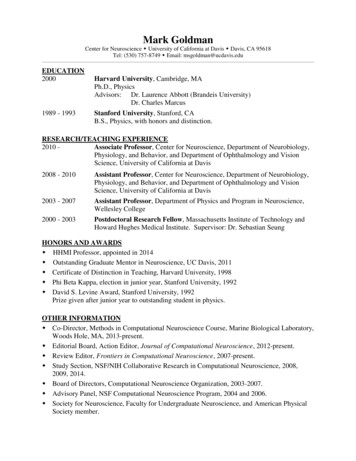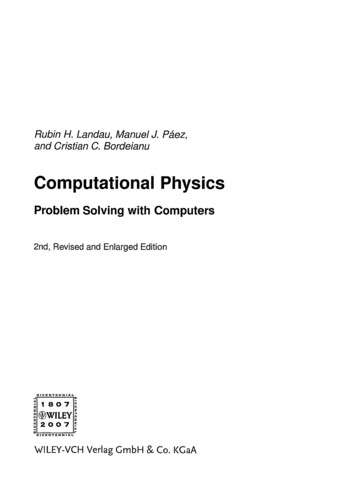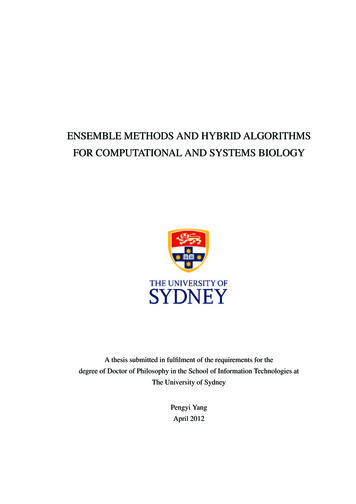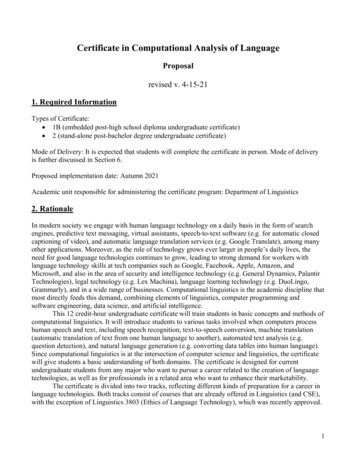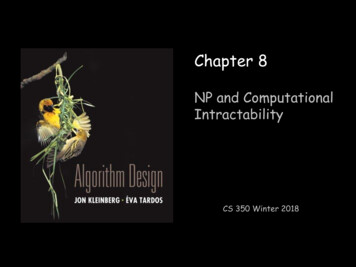
Transcription
Chapter 8NP and ComputationalIntractabilityCS 350 Winter 20181
Algorithm Design Patterns and Anti-PatternsAlgorithm design patterns.Greedy.Divide-and-conquer.Dynamic programming.Duality.Reductions.Local search.Randomization.Algorithm design Undecidability.Ex.O(n log n) interval scheduling.O(n log n) FFT.O(n2) edit distance.O(n3) bipartite matching.O(nk) algorithm unlikely.O(nk) certification algorithm unlikely.No algorithm possible.2
8.1 Polynomial-Time Reductions
Classify Problems According to Computational RequirementsQ. Which problems will we be able to solve in practice?A working definition.[von Neumann 1953, Godel 1956, Cobham 1964, Edmonds 1965, Rabin1966]Those with polynomial-time algorithms.YesProbably noShortest pathLongest pathMatching3D-matchingMin cutMax cut2-SAT3-SATPlanar 4-colorPlanar 3-colorBipartite vertex coverVertex coverPrimality testingFactoring4
Classify ProblemsDesiderata. Classify problems according to those that can be solved inpolynomial-time and those that cannot.Provably requires exponential-time.Given a Turing machine, does it halt in at most k steps? (the HaltingProblem)Given a board position in an n-by-n generalization of chess,can black guarantee a win?Frustrating news. Huge number of fundamental problems have defiedclassification for decades.This chapter. Show that these fundamental problems are"computationally equivalent" and appear to be different manifestationsof one really hard problem.5
Polynomial-Time ReductionDesiderata'. Suppose we could solve X in polynomial-time. What elsecould we solve in polynomial time?don't confuse with reduces fromReduction. Problem X polynomial reduces to problem Y if arbitraryinstances of problem X can be solved using:Polynomial number of standard computational steps, plusPolynomial number of calls to oracle that solves problem Y.Notation. X P Y.computational model supplemented by special pieceof hardware that solves instances of Y in a single stepRemarks.We pay for time to write down instances sent to black box instances of Y must be of polynomial size.6
Polynomial-Time ReductionPurpose. Classify problems according to relative difficulty.Design algorithms. If X P Y and Y can be solved in polynomial-time,then X can also be solved in polynomial time.Establish intractability. If X P Y and X cannot be solved inpolynomial-time, then Y cannot be solved in polynomial time.Establish equivalence. If X P Y and Y P X, we use notation X P Y.up to cost of reduction7
Reduction By Simple EquivalenceBasic reduction strategies. Reduction by simple equivalence. Reduction from special case to general case. Reduction by encoding with gadgets.
Independent SetINDEPENDENT SET: Given a graph G (V, E) and an integer k, is there asubset of vertices S V such that S k, and for each edge at mostone of its endpoints is in S?Ex. Is there an independent set of size 6? Yes.Ex. Is there an independent set of size 7? No.independent set9
Vertex CoverVERTEX COVER: Given a graph G (V, E) and an integer k, is there asubset of vertices S V such that S k, and for each edge, at leastone of its endpoints is in S?Ex. Is there a vertex cover of size 4? Yes.Ex. Is there a vertex cover of size 3? No.vertex cover10
Vertex Cover and Independent SetClaim. VERTEX-COVER P INDEPENDENT-SET.Pf. We show S is an independent set iff V S is a vertex cover.independent setvertex cover11
Vertex Cover and Independent SetClaim. VERTEX-COVER P INDEPENDENT-SET.Pf. We show S is an independent set iff V S is a vertex cover. Let S be any independent set.Consider an arbitrary edge (u, v).S independent u S or v S u V S or v V S.Thus, V S covers (u, v). Let V S be any vertex cover.Consider two nodes u S and v S.Observe that (u, v) E since V S is a vertex cover.Thus, no two nodes in S are joined by an edge S independent set. 12
Reduction from Special Case to General CaseBasic reduction strategies. Reduction by simple equivalence. Reduction from special case to general case. Reduction by encoding with gadgets.
Set CoverSET COVER: Given a set U of elements, a collection S1, S2, . . . , Sm ofsubsets of U, and an integer k, does there exist a collection of k ofthese sets whose union is equal to U?Sample application.m available pieces of software.Set U of n capabilities that we would like our system to have.The ith piece of software provides the set Si U of capabilities.Goal: achieve all n capabilities using fewest pieces of software.Ex:U { 1, 2, 3, 4, 5, 6, 7 }k 2S1 {3, 7}S4 {2, 4}S2 {3, 4, 5, 6}S5 {5}S3 {1}S6 {1, 2, 6, 7}14
Vertex Cover Reduces to Set CoverClaim. VERTEX-COVER P SET-COVER.Pf. Given a VERTEX-COVER instance G (V, E), k, we construct a setcover instance whose size equals the size of the vertex cover instance.Construction.Create SET-COVER instance:– k k, U E, Sv {e E : e incident to v }Set-cover of size k iff vertex cover of size k. VERTEX COVERae7e2e3e4e6fk 2SET COVERbce5e1eU { 1, 2, 3, 4, 5, 6, 7 }k 2Sa {3, 7}Sb {2, 4}Sc {3, 4, 5, 6}Sd {5}Se {1}Sf {1, 2, 6, 7}d15
Polynomial-Time ReductionBasic strategies.Reduction by simple equivalence.Reduction from special case to general case.Reduction by encoding with gadgets.16
8.2 Reductions via "Gadgets"Basic reduction strategies. Reduction by simple equivalence. Reduction from special case to general case. Reduction via "gadgets."
SatisfiabilityLiteral: A Boolean variable or its negation.xi or xiClause: A disjunction of literals.C j x1 x2 x3 Conjunctive normal form: A propositional formula that is the conjunction of clauses. C1 C2 C3 C4 SAT: Given CNF formula , does it have a satisfying truth assignment?3-SAT: SAT where each clause contains exactly 3 literals.each corresponds to a different variableEx: x1 x2 x3 x1 x2 x3 x2 x3 x1 x2 x3 Yes: x1 true, x2 true x3 false. 18
3 Satisfiability Reduces to Independent SetClaim. 3-SAT P INDEPENDENT-SET.Pf. Given an instance of 3-SAT, we construct an instance (G, k) ofINDEPENDENT-SET that has an independent set of size k iff issatisfiable.Construction.G contains 3 vertices for each clause, one for each literal.Connect 3 literals in a clause in a triangle.Connect literal to each of its negations.x2x1x1G x2k 3x3 x1 x1 x2 x3 x3 x1 x2 x3 x2 x1x4 x2 x4 19
3 Satisfiability Reduces to Independent SetClaim. G contains independent set of size k iff is satisfiable.Pf. Let S be independent set of size k.S must contain exactly one vertex in each triangle.and any other variables in a consistent waySet these literals to true.Truth assignment is consistent and all clauses are satisfied.Pf Given satisfying assignment, select one true literal from eachtriangle. This is an independent set of size k. x2x1x1G x2k 3x3 x1 x1 x2 x3 x3 x1 x2 x3 x2 x1x4 x2 x4 20
ReviewBasic reduction strategies.Simple equivalence: INDEPENDENT-SET P VERTEX-COVER.Special case to general case: VERTEX-COVER P SET-COVER.Encoding with gadgets: 3-SAT P INDEPENDENT-SET.Transitivity. If X P Y and Y P Z, then X P Z.Pf idea. Compose the two algorithms.Ex: 3-SAT P INDEPENDENT-SET P VERTEX-COVER P SET-COVER.21
Self-ReducibilityDecision problem. Does there exist a vertex cover of size k?Search problem. Find vertex cover of minimum cardinality.Self-reducibility. Search problem P decision version.Applies to all (NP-complete) problems in this chapter.Justifies our focus on decision problems.Ex: to find min cardinality vertex cover.(Binary) search for cardinality k* of min vertex cover.Find a vertex v such that G { v } has a vertex cover of size k* - 1.– any vertex in any min vertex cover will have this propertyInclude v in the vertex cover.Recursively find a min vertex cover in G { v }.delete v and all incident edges22
8.3 Definition of NP
Decision ProblemsDecision problem.X is a set of strings.Instance: string s.Algorithm A solves problem X: A(s) yes iff s X.Polynomial time. Algorithm A runs in poly-time if for every string s,A(s) terminates in at most p( s ) "steps", where p( ) is some polynomial.length of sPRIMES: X { 2, 3, 5, 7, 11, 13, 17, 23, 29, 31, 37, . }Algorithm. [Agrawal-Kayal-Saxena, 2002] p( s ) s 8.24
Definition of PP. Decision problems for which there is a poly-time Is x a multiple of y?Grade schooldivision51, 1751, 16RELPRIMEAre x and y relatively prime?Euclid (300 BCE)34, 3934, 51PRIMESIs x prime?AKS (2002)5351EDITDISTANCEIs the edit distance betweenx and y less than VEIs there a vector x thatsatisfies Ax b?Gauss-Edmondselimination 0 1 1 2 4 2 , 0 3 15 4 2 36 1 0 0 1 1 1 1 , 1 0 1 1 1 25
NPCertification algorithm intuition.Certifier views things from "managerial" viewpoint.Certifier doesn't determine whether s X on its own;rather, it checks a proposed proof t that s X.Def. Algorithm C(s, t) is a certifier for problem X if for every string s,s X iff there exists a string t such that C(s, t) yes."certificate" or "witness"NP. Decision problems for which there exists a poly-time certifier.C(s, t) is a poly-time algorithm and t p( s ) for some polynomial p( ).Remark. NP stands for nondeterministic polynomial-time.26
Certifiers and Certificates: CompositeCOMPOSITES. Given an integer s, is s composite?Certificate. A nontrivial factor t of s. Note that such a certificateexists iff s is composite. Moreover t s .Certifier.boolean C(s, t) {if (t 1 or t s)return falseelse if (s is a multiple of t)return trueelsereturn false}Instance. s 437,669.Certificate. t 541 or 809.437,669 541 809Conclusion. COMPOSITES is in NP.27
Certifiers and Certificates: 3-SatisfiabilitySAT. Given a CNF formula , is there a satisfying assignment?Certificate. An assignment of truth values to the n boolean variables.Certifier. Check that each clause in has at least one true literal.Ex. x1 x2 x3 x1 x2 x3 x1 x2 x4 x1 x3 x4 instance s x1 1, x2 1, x3 0, x4 1certificate tConclusion. SAT is in NP.28
Certifiers and Certificates: Hamiltonian CycleHAM-CYCLE. Given an undirected graph G (V, E), does there exist asimple cycle C that visits every node?Certificate. A permutation of the n nodes.Certifier. Check that the permutation contains each node in V exactlyonce, and that there is an edge between each pair of adjacent nodes inthe permutation.Conclusion. HAM-CYCLE is in NP.instance scertificate t29
P, NP, EXPP. Decision problems for which there is a poly-time algorithm.EXP. Decision problems for which there is an exponential-time algorithm.NP. Decision problems for which there is a poly-time certifier.Claim. P NP.Pf. Consider any problem X in P.By definition, there exists a poly-time algorithm A(s) that solves X.Certificate: t , certifier C(s, t) A(s). Claim. NP EXP.Pf. Consider any problem X in NP.By definition, there exists a poly-time certifier C(s, t) for X.To solve input s, run C(s, t) on all strings t with t p( s ).Return yes, if C(s, t) returns yes for any of these. 30
The Main Question: P Versus NPDoes P NP? [Cook 1971, Edmonds, Levin, Yablonski, Gödel]Is the decision problem as easy as the certification problem?Clay 1 million prize.NPEXPEXPPP NPIf P NPIf P NPwould break RSA cryptography(and potentially collapse economy)If yes: Efficient algorithms for 3-COLOR, TSP, FACTOR, SAT, If no: No efficient algorithms possible for 3-COLOR, TSP, SAT, Consensus opinion on P NP? Probably no.31
8.4 NP-Completeness
Polynomial TransformationDef. Problem X polynomial reduces (Cook) to problem Y if arbitraryinstances of problem X can be solved using:Polynomial number of standard computational steps, plusPolynomial number of calls to oracle that solves problem Y.Def. Problem X polynomial transforms (Karp) to problem Y if given anyinput x to X, we can construct an input y such that x is a yes instanceof X iff y is a yes instance of Y.we require y to be of size polynomial in x Note. Polynomial transformation is polynomial reduction with just onecall to oracle for Y, exactly at the end of the algorithm for X. Almostall previous reductions were of this form.Open question. Are these two concepts the same with respect to NP?we abuse notation p and blur distinction33
NP-CompleteNP-complete. A problem Y in NP with the property that for everyproblem X in NP, X p Y.Theorem. Suppose Y is an NP-complete problem. Then Y is solvable inpoly-time iff P NP.Pf. If P NP then Y can be solved in poly-time since Y is in NP.Pf. Suppose Y can be solved in poly-time.Let X be any problem in NP. Since X p Y, we can solve X inpoly-time. This implies NP P.We already know P NP. Thus P NP. Fundamental question. Do there exist "natural" NP-complete problems?34
Circuit SatisfiabilityCIRCUIT-SAT. Given a combinational circuit built out of AND, OR, and NOTgates, is there a way to set the circuit inputs so that the output is 1?output yes: 1 0 11 0hard-coded inputs ?inputs35
The "First" NP-Complete ProblemTheorem. CIRCUIT-SAT is NP-complete. [Cook 1971, Levin 1973]Pf. (sketch)Any algorithm that takes a fixed number of bits n as input andproduces a yes/no answer can be represented by such a circuit.Moreover, if algorithm takes poly-time, then circuit is of poly-size.sketchy part of proof; fixing the number of bits is important,and reflects basic distinction between algorithms and circuitsConsider some problem X in NP. It has a poly-time certifier C(s, t).To determine whether s is in X, need to know if there exists acertificate t of length p( s ) such that C(s, t) yes.View C(s, t) as an algorithm on s p( s ) bits (input s, certificate t)and convert it into a poly-size circuit K.– first s bits are hard-coded with s– remaining p( s ) bits represent bits of tCircuit K is satisfiable iff C(s, t) yes.36
ExampleEx. Construction below creates a circuit K whose inputs can be set sothat K outputs true iff graph G has an independent set of size 2. independent set?both endpoints of some edge have been chosen?independent set of size 2? uvwG (V, E), n 3set of size 2? u-vu-wv-wuvw101? n hard-coded 2 inputs (graph description)n inputs (nodes in independent set)37
Establishing NP-CompletenessRemark. Once we establish first "natural" NP-complete problem,others fall like dominoes.Recipe to establish NP-completeness of problem Y.Step 1. Show that Y is in NP.Step 2. Choose an NP-complete problem X.Step 3. Prove that X p Y.Justification. If X is an NP-complete problem, and Y is a problem in NPwith the property that X P Y then Y is NP-complete.Pf. Let W be any problem in NP. Then W P X P Y.By transitivity, W P Y.by definition ofby assumptionHence Y is NP-complete. NP-complete38
3-SAT is NP-CompleteTheorem. 3-SAT is NP-complete.Pf. Suffices to show that CIRCUIT-SAT P 3-SAT since 3-SAT is in NP.Let K be any circuit.Create a 3-SAT variable xi for each circuit element i.Make circuit compute correct values at each node:– x2 x3 add 2 clauses: x2 x3 , x2 x3– x1 x4 x5 add 3 clauses:x1 x4 , x1 x5 , x1 x4 x5– x0 x1 x2 add 3 clauses:x0 x1 , x0 x2 , x0 x1 x2 output value.Hard-coded input values and– x5 0 add 1 clause: x5x0– x0 1 add 1 clause: of length 3 intoFinal step: turn clauses clauses of length exactly3. outputx0 x1x2 x50?x4?x339
NP-CompletenessObservation. All problems below are NP-complete and polynomialreduce to one another!CIRCUIT-SATby definition of NP-completeness3-SATINDEPENDENT SETDIR-HAM-CYCLEGRAPH 3-COLORSUBSET-SUMVERTEX COVERHAM-CYCLEPLANAR 3-COLORSCHEDULINGSET COVERTSP40
Some NP-Complete ProblemsSix basic genres of NP-complete problems and paradigmatic examples.Packing problems: SET-PACKING, INDEPENDENT SET.Covering problems: SET-COVER, VERTEX-COVER.Constraint satisfaction problems: SAT, 3-SAT.Sequencing problems: HAMILTONIAN-CYCLE, TSP.Partitioning problems: 3D-MATCHING 3-COLOR.Numerical problems: SUBSET-SUM, KNAPSACK.Practice. Most NP problems are either known to be in P or NP-complete.Notable exceptions. Factoring, graph isomorphism, Nash equilibrium.41
Extent and Impact of NP-CompletenessExtent of NP-completeness. [Papadimitriou 1995]Prime intellectual export of CS to other disciplines.6,000 citations per year (title, abstract, keywords).– more than "compiler", "operating system", "database"Broad applicability and classification power."Captures vast domains of computational, scientific, mathematicalendeavors, and seems to roughly delimit what mathematicians andscientists had been aspiring to compute feasibly."NP-completeness can guide scientific inquiry.1926: Ising introduces simple model for phase transitions.1944: Onsager solves 2D case in tour de force.19xx: Feynman and other top minds seek 3D solution.2000: Istrail proves 3D problem NP-complete.42
More Hard Computational ProblemsAerospace engineering: optimal mesh partitioning for finite elements.Biology: protein folding.Chemical engineering: heat exchanger network synthesis.Civil engineering: equilibrium of urban traffic flow.Economics: computation of arbitrage in financial markets with friction.Electrical engineering: VLSI layout.Environmental engineering: optimal placement of contaminant sensors.Financial engineering: find minimum risk portfolio of given return.Game theory: find Nash equilibrium that maximizes social welfare.Genomics: phylogeny reconstruction.Mechanical engineering: structure of turbulence in sheared flows.Medicine: reconstructing 3-D shape from biplane angiocardiogram.Operations research: optimal resource allocation.Physics: partition function of 3-D Ising model in statistical mechanics.Politics: Shapley-Shubik voting power.Pop culture: Minesweeper consistency.Statistics: optimal experimental design.43
Kleinberg HW 8.1#1: Decide whether the answer for each is yes, no or “unknown” because it wouldresolve whether P NP.(a)Let’s define the decision version of the Interval Scheduling Problem fromChapter 4 as follows: Given a collection of intervals on a time-line, and bound k,does the collection contain a subset of nonoverlapping intervals of size at leastk?Question: Is it the case that Interval Scheduling P Vertex Cover?44
Kleinberg HW 8.1#1: Decide whether the answer for each is yes, no or “unknown” because it wouldresolve whether P NP.(a)Let’s define the decision version of the Interval Scheduling Problem fromChapter 4 as follows: Given a collection of intervals on a time-line, and bound k,does the collection contain a subset of nonoverlapping intervals of size at leastk?Question: Is it the case that Interval Scheduling P Vertex Cover?Yes. One solution: Interval Scheduling can be solved in polynomial time, and so itcan also be solved in polynomial time with access to a black box for Vertex Cover.Another solution: Interval Scheduling is in NP, and anything in NP can be reducedto Vertex Cover.45
Kleinberg HW 8.1#1: Decide whether the answer for each is yes, no or “unknown” because it wouldresolve whether P NP.(b) Question: Is it the case that Independent Set P Interval Scheduling?46
Kleinberg HW 8.1#1: Decide whether the answer for each is yes, no or “unknown” because it wouldresolve whether P NP.(b) Question: Is it the case that Independent Set P Interval Scheduling?This is equivalent to P NP.If P NP, then Independent Set can be solved in polynomial time, so IndependentSet P Interval Scheduling. Conversely, if Independent Set P Interval Scheduling,then since Interval Scheduling can be solved in polynomial time, so couldIndependent Set. But Independent Set is NP-complete, so solving it in polynomialtime would imply P NP.47
Kleinberg HW 8.2#2: A store trying to analyze the behavior of its customers will often maintain a 2-d array A,where the rows correspond to its customers, and the columns correspond to the products itsells. The entry A[i,j] specifies the quantity of product j that has been purchased by customeri.LiquidbeerdetergentdiapersCat litterRaj0603Alanis2300Chelsea0007Example:One thing that a store might want to do with these data is the following: Let us say that asubset S of the customers is diverse if no two of the customers in S have ever bought thesame product (i.e. for each product, at most one of the customers in S has ever bought it).Adiverse set of customers can be useful, for example, as a target pool for market research.We now define the Diverse Subset Problem as follows: Given an m x n array A as definedabove, and a number k m, is there a subset of at least k of the customers that is diverse?Show that Diverse Subset is NP-complete.48
Kleinberg HW 8.2#2: Let us say that a subset S of the customers is diverse if no two of the customers in Shave ever bought the same product (i.e. for each product, at most one of the customers in Shas ever bought it).A diverse set of customers can be useful, for example, as a target pool formarket research.We now define the Diverse Subset Problem as follows: Given an m x n array A as definedabove, and a number k m, is there a subset of at least k of the customers that is diverse?Show that Diverse Subset is NP-complete.First: The problem itself is NP because we can exhibit a set of k customers, and inpolynomial time we can check that no two bought any product in common.Next we show NP-complete 49
Kleinberg HW 8.2#2: We now define the Diverse Subset Problem as follows: Given an m x n array A as definedabove, and a number k m, is there a subset of at least k of the customers that is diverse?Show that Diverse Subset is NP-complete.First: The problem itself is NP because we can exhibit a set of k customers, and inpolynomial time we can check that no two bought any product in common.Next we show NP-complete in particular, we show that: Independent Set P DiverseSubset.Given a graph G and a number k, we construct a customer for each node of G, and aproduct for each edge of G. We then build an array that says customer v boughtproduct e if edge e is incident to node v. Finally, we ask whether this array has a diversesubset of size k.Claim: this holds if and only if G has an independent set of size k (you should be able toargue this directly, then we’re done).50
Kleinberg HW 8.3#3: Suppose you’re helping to organize a summer sports camp, and the following problem comesup. The camp is supposed to have at least one counselor who’s skilled at each of the n sportscovered by the camp (baseball, volleyball, etc.). They have received job applications from mpotential counselors. For each of the n sports, there is some subset of the m applicantsqualified in that sport.The question is: For a given number k m, is it possible to hire at most k of the counselors andhave at least one counselor qualified in each of the n sports? Call this the Efficient RecruitingProblem.Show that Efficient Recruiting is NP-complete.51
Kleinberg HW 8.3#3: Suppose you’re helping to organize a summer sports camp, and the following problem comesup. The camp is supposed to have at least one counselor who’s skilled at each of the n sportscovered by the camp (baseball, volleyball, etc.). They have received job applications from mpotential counselors. For each of the n sports, there is some subset of the m applicantsqualified in that sport.The question is: For a given number k m, is it possible to hire at most k of the counselors andhave at least one counselor qualified in each of the n sports? Call this the Efficient RecruitingProblem.Show that Efficient Recruiting is NP-complete.First: The problem is in NP since, given a set of k counselors, we can check that they cover allthe sports.Next: Suppose we had such an algorithm A: here is how we would solve an instance of VertexCover.52
Kleinberg HW 8.3#3:The question is: For a given number k m, is it possible to hire at most k of the counselors andhave at least one counselor qualified in each of the n sports? Call this the Efficient RecruitingProblem.Show that Efficient Recruiting is NP-complete.First: The problem is in NP since, given a set of k counselors, we can check that they cover all thesports.Next: Suppose we had such an algorithm A: here is how we would solve an instance of Vertex Cover.Given a graph G (V,E) and an integer k, we would define a sport Se for each edge e, and a counselor Cvfor each vertex v. Cv is qualified in sport Se if and only if e has an endpoint equal to v.Finally show that a vertex cover of size k in this graph corresponds with having k counselors that arequalified in all sports (and vice versa). Now you should have the answer 53
Algorithm Design Patterns and Anti-Patterns Algorithm design patterns. Ex. Greedy. O(n log n) interval scheduling. . Primality testing Factoring Planar 4-color Planar 3-color Bipartite vertex cover Vertex cover. 5 Classify Problems . computational model supplemented by special piece of hardware that solves instances of Y in a single step. 7 .
